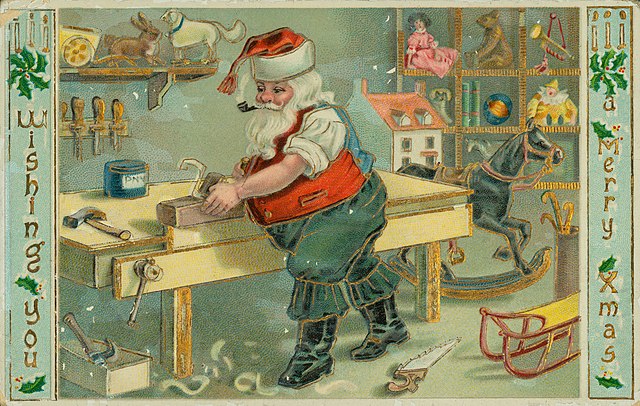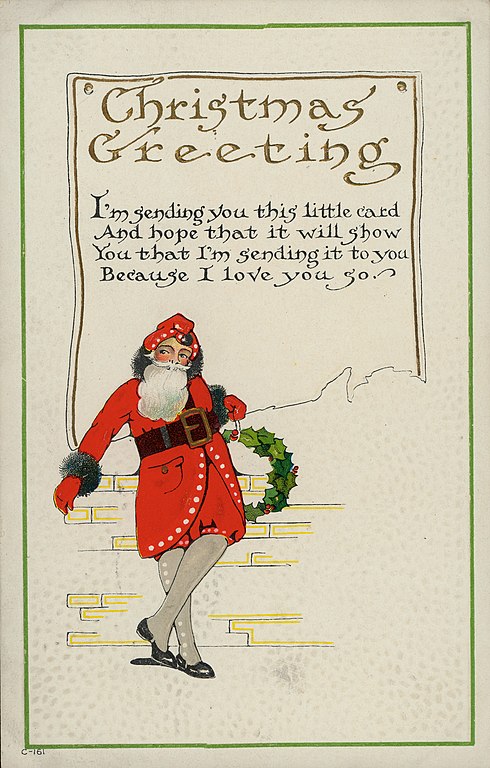
Santa Claus, also known as Father Christmas, Saint Nicholas, Saint Nick, Kris Kringle, or simply Santa, is a legendary figure originating in Western Christian culture who is said to bring gifts during the late evening and overnight hours on Christmas Eve.
He is said to accomplish this with the aid of Christmas elves, who make the toys in his North Pole workshop, and with the aid of flying reindeer who pull his sleigh through the air.
The modern figure of Santa is based on folklore traditions surrounding Saint Nicholas, the English figure of Father Christmas, and the Dutch figure of Sinterklaas.
Santa is generally depicted as a portly, jolly, white-bearded man, often with spectacles, wearing a red coat with white fur collar and cuffs, white-fur-cuffed red trousers, a red hat trimmed with white fur, a black leather belt and boots, carrying a bag full of gifts for children. He is popularly associated with a deep, hearty laugh, frequently rendered in Christmas literature as “ho, ho, ho!”
This image originated in North America during the 19th century and has been maintained and reinforced through song, radio, television, children’s books, family Christmas traditions, films, and advertising.
The Thammasat University Library has acquired a book, We Are Santa: Portraits & Profiles that may be useful for students interested in folklore, comparative religion, sociology, literature, and related subjects.
The book recounts the experiences of fifty professional Santas from across the United States of America.
Custom-made costumes and specialized training are described.

Old Santeclaus with Much Delight is an anonymous illustrated children’s poem published in New York in 1821, predating by two years the first publication of A Visit from St. Nicholas (Twas the Night before Christmas).
Old Santeclaus with Much Delight is the first publication to mention (and illustrate) Santa Claus’s reindeer and his sleigh, as well as being the first to describe his arrival on Christmas Eve. The accompanying illustrations are the earliest published artistic depictions of a Santa Claus figure.
The names of the author and the illustrator are not known.
According to the early tradition, Santeclaus brings presents for good children, but punishes naughty children.
This former religious message has been forgotten over time, and I more recent years, Santa Claus is mainly remembered for bringing gifts:
Old SANTECLAUS with much delight
His reindeer drives this frosty night,
O’r chimney tops, and tracts of snow,
To bring his yearly gifts to you.
The steady friend of virtuous youth,
The friend of duty, and of truth,
Each Christmas eve he joys to come
Where peace and love have made their home.
Through many houses he has been,
And various beds and stockings seen;
Some, white as snow, and neatly mended,
Others, that seemed for pigs intended.
To some I gave a pretty doll,
To some a peg-top, or a ball;
No crackers, cannons, squibs, or rockets,
To blow their eyes up, or their pockets.
Where e’re I found good girls or boys,
That hated quarrels, strife and noise,
I left an apple, or a tart,
Or wooden gun, or painted cart;
No drums to stun their Mother’s ear,
Nor swords to make their sisters fear;
But pretty books to store their mind
With knowledge of each various kind.
But where I found the children naughty,
In manners crude, in temper haughty,
Thankless to parents, liars, swearers,
Boxers, or cheats, or base tale-bearers,
I left a long, black, birchen rod,
Such as the dread command of GOD
Directs a Parent’s hand to use
When virtue’s path his sons refuse.

Another famous text about Santa Claus is Yes, Virginia, there is a Santa Claus, a line from an editorial by Francis Pharcellus Church.
Written in response to a letter by eight-year-old Virginia O’Hanlon asking whether Santa Claus was real, the editorial was first published in the New York newspaper The Sun on September 21, 1897.
The editorial was quickly republished by other New York newspapers.
The Sun soon began regularly republishing the editorial during the Christmas and holiday season.
The editorial is widely reprinted during the holiday season, and is the most reprinted newspaper editorial in the English language. It has been translated into around 20 languages and adapted as television specials, a film, a musical, and a cantata.
The letter from eight-year-old Virginia O’Hanlon follows:
Dear Editor,
I am 8 years old. Some of my little friends say that there is no Santa Claus. Papa says “If you see it in the Sun, it is so.” Please tell me the truth, is there a Santa Claus?
Here is the response from the newspaper editorial writer, underlining that fantasies and myths are important and can be spiritually, if not literally, true:
Virginia,
Your little friends are wrong. They have been affected by the skepticism of a skeptical age. They do not believe except what they see. They think that nothing can be which is not comprehensible by their little minds.
All minds, Virginia, whether they be men’s or children’s, are little. In this great universe of ours, man is a mere insect, an ant, in his intellect, as compared with the boundless world about him, as measured by the intelligence capable of grasping the whole of truth and knowledge.
Yes, Virginia, there is a Santa Claus. He exists as certainly as love and generosity and devotion exist, and you know that they abound and give to our life its highest beauty and joy.
Alas! How dreary would be the world if there were no Santa Claus! It would be as dreary as if there were no Virginias. There would be no childlike faith then, no poetry, no romance to make tolerable this existence. We should have no enjoyment, except in sense and sight. The eternal light with which childhood fills the world would be extinguished.
Not believe in Santa Claus? You might as well not believe in fairies! You might get your Papa to hire men to watch all the chimneys on Christmas Eve to catch Santa Claus, but even if they did not see Santa Claus coming down, what would that prove?
Nobody sees Santa Claus, but that is no sign that there is no Santa Claus The most real things in the world are those that neither children nor men can see.
Did you ever see fairies dancing on the lawn? Of course not, but that’s no proof that they are not there. Nobody can conceive or imagine all the wonders that are unseen and unseeable in the world.
You tear apart the baby’s rattle and see what makes the noise inside, but there is a veil covering the unseen world which not the strongest man, or even the united strength of all the strongest men that ever lived, could tear apart. Only faith, fancy, poetry, love, romance, can push aside that curtain and view and picture the supernatural beauty and glory beyond.
Is it all real? Ah, Virginia, in all this world there is nothing else as real and abiding.
No Santa Claus? Thank God he lives and he lives forever. A thousand years from now, maybe 10 times 10,000 years from now, he will continue to make glad the hearts of children.

(All images courtesy of Wikimedia Commons)
